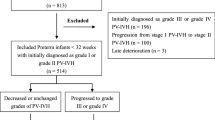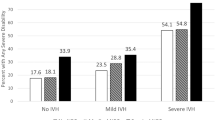Abstract
Objective:
The objective of the study was to determine whether withdrawal of support in severe ‘intraventricular hemorrhage’ (IVH), that is, IVH grade 3 and periventricular hemorrhagic infarction (PVHI), has decreased after publication of studies that show improved prognosis and to examine cranial ultrasonograms, including PVHI territories defined by Bassan.
Study Design:
Retrospective cohort of preterm infants from 23 0/7 to 28 6/7 weeks’ gestation in 1993 to 2013.
Results:
Among the 1755 infants, 1494 had no bleed, germinal matrix hemorrhage (GMH) or IVH grade 2, 137 had grade 3 IVH and 124 had PVHI. The odds of withdrawal of support, adjusted for severity of GMH-IVH and baseline variables, did not decrease after publications showing better prognosis. Among 82 patients who died with PVHI, 76 had life support withdrawn, including 34 without another contributing cause of death. The median number of PVHI territories involved was three.
Conclusion:
Withdrawal of support adjusted for severity of GMH-IVH did not significantly change after publications showing better prognosis.
This is a preview of subscription content, access via your institution
Access options
Subscribe to this journal
Receive 12 print issues and online access
$259.00 per year
only $21.58 per issue
Buy this article
- Purchase on Springer Link
- Instant access to full article PDF
Prices may be subject to local taxes which are calculated during checkout


Similar content being viewed by others

References
Volpe JJ. Neurology of the Newborn, 4th edn. W.B. Saunders: Philadephia, PA, USA, 2001, pp 428–493.
Goldstein RF, Cotten CM, Shankaran S, Gantz MG, Poole WK . Influence of gestational age on death and neurodevelopmental outcome in premature infants with severe intracranial hemorrhage. J Perinatol 2013; 33: 25–32.
Bassan H, Feldman HA, Limperopoulos C, Benson CB, Ringer SA, Veracruz E et al. Periventricular hemorrhagic infarction: risk factors and neonatal outcome. Pediatr Neurol 2006; 35: 85–92.
Roze E, Kerstjens JM, Maathuis CG, ter Horst HJ, Bos AF . Risk factors for adverse outcome in preterm infants with periventricular hemorrhagic infarction. Pediatrics 2008; 122: e46–e52.
Bassan H, Benson CB, Limperopoulos C, Feldman HA, Ringer SA, Veracruz E et al. Ultrasonographic features and severity scoring of periventricular hemorrhagic infarction in relation to risk factors and outcome. Pediatrics 2006; 117: 2111–2118.
Brouwer A, Groenendaal F, van Haastert IL, Rademaker K, Hanlo P, de Vries L . Neurodevelopmental outcome of preterm infants with severe intraventricular hemorrhage and therapy for post-hemorrhagic ventricular dilatation. J Pediatr 2008; 152: 648–654.
Davis AS, Hintz SR, Goldstein RF, Ambalavanan N, Bann CM, Stoll BJ et al. Outcomes of extremely preterm infants following severe intracranial hemorrhage. J Perinatol 2014; 34: 203–208.
Hellmann J, Knighton R, Lee SK, Shah PS Canadian Neonatal Network End of Life Study Group. Neonatal deaths: prospective exploration of the causes and process of end-of-life decisions. Arch Dis Child Fetal Neonatal Ed 2016; 101: F102–F107.
Stewart AL . Prediction of long-term outcome in high-risk infants: the use of objective measures of brain structure and function in the neonatal intensive care unit. Baillieres Clin Obstetr Gynaecol 1988; 2: 221–236.
Bassan H, Limperopoulos C, Visconti K, Mayer DL, Feldman HA, Avery L et al. Neurodevelopmental outcome in survivors of periventricular hemorrhagic infarction. Pediatrics 2007; 120: 785–792.
Roze E, Van Braeckel KN, van der Veere CN, Maathuis CG, Martijn A, Bos AF . Functional outcome at school age of preterm infants with periventricular hemorrhagic infarction. Pediatrics 2009; 123: 1493–1500.
O'Shea TM, Kuban KCK, Allred EN, Paneth N, Pagano M, Dammann O et al. Neonatal cranial ultrasound lesions and developmental delays at 2 years of age among extremely low gestational age children. Pediatrics 2008; 122: E662–E669.
Kuban KC, Allred EN, O'Shea TM, Paneth N, Pagano M, Dammann O et al. Cranial ultrasound lesions in the NICU predict cerebral palsy at age 2 years in children born at extremely low gestational age. J Child Neurol 2009; 24: 63–72.
Woodward LJ, Anderson PJ, Austin NC, Howard K, Inder TE . Neonatal MRI to predict neurodevelopmental outcomes in preterm infants. N Engl J Med 2006; 355: 685–694.
Hintz SR, Barnes PD, Bulas D, Slovis TL, Finer NN, Wrage LA et al. Neuroimaging and neurodevelopmental outcome in extremely preterm infants. Pediatrics 2015; 135: e32–e42.
Corbett SS, Rosenfeld CR, Laptook AR, Risser R, Maravilla AM, Dowling S et al. Intraobserver and interobserver reliability in assessment of neonatal cranial ultrasounds. Early Hum Dev 1991; 27: 9–17.
Kuban K, Adler, Allred EN, Batton D, Bezinque S, Betz BW et al. Observer variability assessing US scans of the preterm brain: the ELGAN study. Pediatr Radiol 2007; 12: 1201–1208.
Papile LA, Burstein J, Burstein R, Koffler H . Incidence and evolution of subependymal and intraventricular hemorrhage: a study of infants with birth weights less than 1,500 gm. J Pediatr 1978; 92: 529–534.
Vohr BR, Stephens BE, Higgins RD, Bann CM, Hintz SR, Das A et al. Are outcomes of extremely preterm infants improving? Impact of Bayley assessment on outcomes. J Pediatr 2012; 161: 222–228.
Palisano R, Rosenbaum P, Walter S, Russell D, Wood E, Galuppi B . Development and reliability of a system to classify gross motor function in children with cerebral palsy. Dev Med Child Neurol 1997; 39: 214–223.
Hintz SR, Newman JE, Vohr BR . Changing definitions of long-term follow-up: should ‘long term’ be even longer? Semin Perinatol 2016; 40: 398–409.
Lowe JR, Erickson SJ, Schrader R, Duncan AF . Comparison of the Bayley II Mental Developmental Index and the Bayley III Cognitive Scale: are we measuring the same thing? Acta Paediatr 2012; 101: e55–e58.
Moore T, Johnson S, Haider S, Hennessy E, Marlow N . Relationship between test scores using the second and third editions of the Bayley Scales in extremely preterm children. J Pediatr 2012; 160: 553–558.
Duncan AF, Bann C, Boatman C, Hintz SR, Vaucher YE, Vohr BR et al. Do currently recommended Bayley-III cutoffs overestimate motor impairment in infants born 27 weeks gestation? J Perinatol 2015; 35: 516–521.
Olsen IE, Groveman SA, Lawson ML, Clark RH, Zemel BS . New intrauterine growth curves based on United States data. Pediatrics 2010; 125: e214–e224.
Wilkinson D . MRI and withdrawal of life support from newborn infants with hypoxic-ischemic encephalopathy. Pediatrics 2010; 126: e451–e458.
Tsai AJ, Lasky RE, John SD, Evans PW, Kennedy KA . Predictors of neurodevelopmental outcomes in preterm infants with intraparenchymal hemorrhage. J Perinatol 2014; 34: 399–404.
Author information
Authors and Affiliations
Corresponding author
Ethics declarations
Competing interests
The authors declare no conflict of interest.
Additional information
Author contributions
Dr Sheehan wrote the first draft of the manuscript. She conceptualized and designed the study. She reviewed data from the database, medical records, participated in the interpretation of the data, critically reviewed revisions and approved the final manuscript. Dr Pritchard conceptualized and designed the study. She reviewed and classified all the ultrasonograms using predefined criteria, without knowledge of prior readings and outcome and participated in data interpretation and critically reviewed the manuscript. Dr Heyne conceptualized and designed the study. He participated in the interpretation of the data, follow-up data review and abstraction, critically reviewed and approved the final manuscript. Mr Brown conceptualized and designed the study. He completed all statistical analyses, participated in the interpretation of the data and critically reviewed the manuscript. Dr Jaleel and Dr Engle conceptualized and designed the study. They participated in the interpretation of the data, critically reviewed and approved the manuscript. Ms Burchfield collected and entered data into the databases and extracted the data for this study. She participated in the interpretation of the data, critically reviewed the manuscript and approved the final manuscript as submitted. Dr Brion conceptualized and designed the study. He participated in the interpretation of the data, critically reviewed, revised and approved the manuscript.
Rights and permissions
About this article
Cite this article
Sheehan, J., Pritchard, M., Heyne, R. et al. Severe intraventricular hemorrhage and withdrawal of support in preterm infants. J Perinatol 37, 441–447 (2017). https://doi.org/10.1038/jp.2016.233
Received:
Revised:
Accepted:
Published:
Issue Date:
DOI: https://doi.org/10.1038/jp.2016.233
This article is cited by
-
Association of antenatal steroids with neonatal mortality and morbidity in preterm infants born to mothers with diabetes mellitus and hypertension
Journal of Perinatology (2021)
-
Cranial ultrasound findings in preterm germinal matrix haemorrhage, sequelae and outcome
Pediatric Research (2020)
-
Research Advances of Germinal Matrix Hemorrhage: An Update Review
Cellular and Molecular Neurobiology (2019)


